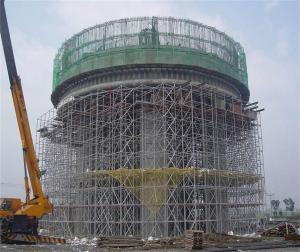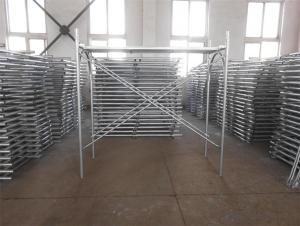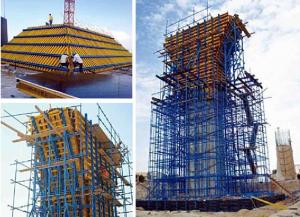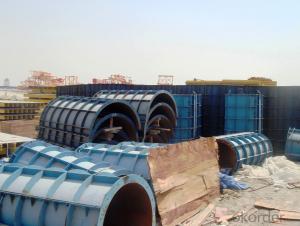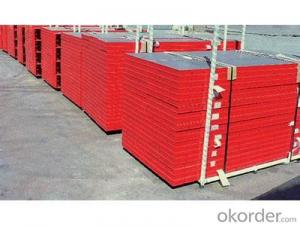Ring-Lock Scaffolding , Door Scaffolding , Tower Scaffolding with Hot or Cold Galvanized Surface
- Loading Port:
- Shanghai
- Payment Terms:
- TT OR LC
- Min Order Qty:
- 1000 m²
- Supply Capability:
- 100000 m²/month
OKorder Service Pledge
OKorder Financial Service
You Might Also Like
1.Structure of Ring lock Description
Ringlock Scaffolding system is the most popular used Scaffolding system in the world.It will greatly reduce the cost because of the following advantages
Packaging & Delivery
Packaging Details:
Pallet or bag or upon client's request
Delivery Detail:
35days
2.Main Features of Ringlock
It will greatly reduce the cost because of the following advantages
1)Using less pipes
2)Easy to install
3)It can be used again and again for nearly 20years
3.Ring lock product pictures:
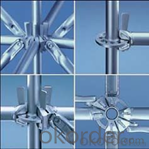
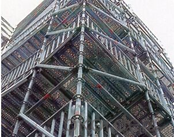
4.Ringlock Product Description
Type: ringlock scaffolding diagonal Brace
specification : Ø48.3×3.20
material:: steel Q235
Finished: Hot DIP galvanized, painted
Diagonal length(m) :Weight(kg)
0.9m * 1.25m 6.28
1.25m * 2.7m 11.45
5.FAQ
We have organized several common questions for our clients,may help you sincerely:
1)How about your company?
CNBM International Corporation, China National Building Materials (Group) Corporation, is one of the largest companies in China building material equipment industry, Our formwork and scaffolding are largely used in both domestic and all over world;
2)How many Scaffolding your company have?
Here comes our 5 types of Scaffolding systems:
- Cup lock Scaffolding(C-Lock Scaffolding)
- Ring lock Scaffolding
-Kwistage Scaffolding
-H-frame Scaffolding
-ID15 Scaffolding Tower, this type Scaffolding is the most widely used in construction, such like bridge.
3)How long can we receive the product after purchase?
Lead time is about 30days after getting the signed PI and deposit.
- Q:How does steel frame formwork handle the placement of stairs and escalators within the concrete structure?
- A versatile and flexible system, steel frame formwork effectively handles the placement of stairs and escalators in concrete structures. When constructing stairs, steel frame formwork provides reliable support. The steel frames easily adjust to desired dimensions and designs, allowing for various types of staircases such as straight flights, spiral stairs, or curved designs. This flexibility promotes creativity in architectural designs and ensures seamless integration into the overall structure. For escalators, steel frame formwork offers necessary strength and stability. It can be designed to match escalator dimensions and configurations, providing a secure framework for installation. The engineered steel frames withstand dynamic forces and vibrations associated with escalator operations, ensuring long-term durability and safety. Additionally, steel frame formwork allows for efficient and speedy construction of stairs and escalators in concrete structures. Prefabricated steel frames are easily assembled and adjusted on-site, reducing construction time and labor costs. The modular system enables quick dismantling and reassembly, ideal for projects requiring frequent changes or modifications in stair and escalator positioning. Overall, steel frame formwork is the preferred choice for architects, contractors, and engineers in constructing buildings with stairs and escalators. Its flexibility, strength, and efficiency make it an ideal solution for incorporating these vertical transportation systems.
- Q:How does steel frame formwork contribute to the overall sustainability of the built environment?
- Steel frame formwork contributes to the overall sustainability of the built environment in several ways. Firstly, steel is a highly durable material that has a long lifespan, meaning that steel frame formwork can be reused numerous times for different construction projects. This reduces the demand for new formwork materials and minimizes waste generation. Additionally, steel frame formwork is a versatile and adaptable solution that can be easily adjusted and modified to accommodate changes in design or construction requirements. This flexibility reduces the need for additional materials and resources, contributing to resource efficiency and reducing the overall environmental impact of the construction process. Moreover, steel is a recyclable material, meaning that at the end of its life cycle, the steel frame formwork can be recycled and used to produce new steel products. This helps to conserve natural resources and reduce the energy and emissions associated with the production of virgin materials. Furthermore, steel frame formwork offers a high level of precision and structural stability, resulting in efficient and robust construction. This reduces the risk of errors and failures during the construction process, leading to fewer material and resource wastages. The overall improved construction quality also enhances the longevity and performance of the built environment, minimizing the need for repairs and replacements in the future. Lastly, steel frame formwork can contribute to the energy efficiency of buildings. The lightweight nature of steel allows for the construction of thinner and more thermally efficient walls, reducing the energy consumption required for heating and cooling. This can result in reduced carbon emissions and lower energy costs throughout the lifespan of the building. In conclusion, steel frame formwork contributes to the overall sustainability of the built environment through its durability, reusability, recyclability, flexibility, and energy efficiency. By incorporating steel frame formwork into construction projects, we can minimize waste generation, conserve resources, reduce environmental impacts, and create buildings that are resilient, efficient, and long-lasting.
- Q:Does steel frame formwork require any special bracing or support during construction?
- Yes, steel frame formwork does require special bracing or support during construction. Steel frame formwork is a type of temporary mold or structure that is used to hold and support wet concrete until it sets and becomes self-supporting. The steel frame formwork system consists of vertical and horizontal metal beams, which are connected using various types of connectors and braces. During construction, the steel frame formwork needs to be properly braced and supported to ensure stability and safety. Bracing is important to prevent the formwork from collapsing or deforming under the weight of the wet concrete. It helps to distribute the load evenly and provides additional support to the formwork system. The type and amount of bracing required for steel frame formwork depend on various factors, such as the height and size of the formwork, the concrete pressure, and the specific design of the structure being built. Bracing can include diagonal or cross braces, tie rods, horizontal and vertical struts, and adjustable clamps or props. The bracing system needs to be carefully designed and installed by experienced professionals to ensure that it can withstand the forces and pressures exerted by the wet concrete. It is crucial to follow the manufacturer's instructions and guidelines for bracing and support to ensure the structural integrity of the steel frame formwork system. In summary, steel frame formwork does require special bracing or support during construction to ensure stability and safety. Proper bracing is essential to prevent collapse or deformation of the formwork system under the weight of the wet concrete. The type and amount of bracing needed depend on various factors and should be designed and installed by professionals following the manufacturer's guidelines.
- Q:Can steel frame formwork be used for both internal and external concrete walls?
- Both internal and external concrete walls can be constructed using steel frame formwork. This versatile and durable system is widely used in construction for various structures, including walls. It offers a sturdy framework for pouring and shaping concrete, ensuring proper alignment and stability throughout the building process. The steel frames can be effortlessly assembled and disassembled, making it ideal for both internal and external walls that require different formwork configurations. Furthermore, steel frame formwork can be easily adjusted to accommodate varying wall thicknesses and heights, providing flexibility in design and construction. In summary, steel frame formwork is a dependable and cost-effective solution for constructing both internal and external concrete walls.
- Q:Can steel frame formwork be used in projects with limited construction site access to construction vehicles or equipment?
- Yes, steel frame formwork can be used in projects with limited construction site access to construction vehicles or equipment. Steel frame formwork is a versatile and durable system that can be easily transported and assembled on-site without the need for extensive machinery or equipment. Its lightweight and modular design allows for manual handling and installation, making it suitable for projects with restricted site access. Additionally, steel frame formwork offers excellent stability and load-bearing capacity, ensuring efficient and safe construction in such conditions.
- Q:How does steel frame formwork contribute to the overall aesthetics of a concrete structure?
- The overall aesthetics of a concrete structure are enhanced by steel frame formwork in various ways. To begin with, the placement of concrete becomes more precise and accurate with steel frame formwork, resulting in a smoother and more uniform finish. This is particularly crucial when the exposed concrete surface is intended to be a prominent design feature. Additionally, steel frame formwork offers flexibility in shaping and molding the concrete. The steel frames can be easily adjusted and customized to create different shapes, curves, and patterns, opening up more creative design possibilities. This allows architects and designers to create concrete structures that are unique and visually appealing, setting them apart from conventional construction methods. Furthermore, steel frame formwork contributes to achieving a consistent and level surface finish across the entire structure. The strong and sturdy nature of steel frames ensures that the formwork remains stable and does not deform during the concrete pouring process. As a result, there is no risk of uneven surfaces or imperfections, resulting in a visually pleasing and professional appearance. Moreover, steel frame formwork also enhances the durability and longevity of the concrete structure. The use of steel frames provides robust support and reinforcement to the concrete, making it more resistant to external forces and potential damage. This guarantees that the structure maintains its aesthetic appeal over time, as the concrete surface remains intact and free from cracks or deterioration. In conclusion, steel frame formwork plays a crucial role in enhancing the overall aesthetics of a concrete structure. It enables precise and accurate concrete placement, offers design flexibility, ensures a consistent and level finish, and contributes to the durability and longevity of the structure. By combining functionality and aesthetics, steel frame formwork helps create visually stunning and architecturally impressive concrete structures.
- Q:How does steel frame formwork handle concrete pouring in hot weather conditions?
- In hot weather conditions, steel frame formwork is widely favored for concrete pouring. This is because it can endure high temperatures without compromising the formwork system's structural integrity. The steel frame provides exceptional strength and stability, guaranteeing the formwork remains intact throughout the concrete pouring process. One major benefit of using steel frame formwork in hot weather is its efficient heat dissipation ability. Steel possesses a high thermal conductivity, allowing it to absorb and transfer heat away from the concrete. This prevents the concrete from experiencing excessive temperature rise. This is particularly crucial in hot weather conditions where the concrete's hydration process may be accelerated, leading to faster setting times and potential loss of strength. Additionally, steel frame formwork is designed to promote adequate ventilation and air circulation. This helps minimize the risk of thermal cracking and ensures that the concrete cures uniformly and evenly. The formwork's open design also facilitates easy inspection of the concrete during pouring, allowing any potential issues to be promptly identified and addressed. Furthermore, steel frame formwork offers a high degree of flexibility and adaptability. This allows for easy adjustments and modifications to accommodate the specific requirements of hot weather concrete pouring. It permits the addition of extra reinforcement or cooling systems to mitigate the effects of high temperatures. Overall, steel frame formwork is an excellent option for concrete pouring in hot weather conditions. Its strength, efficient heat dissipation capabilities, and flexibility make it well-suited to handle the challenges posed by high temperatures. As a result, it ensures that the concrete sets properly and achieves the desired strength and durability.
- Q:Can steel frame formwork be used for curved or irregularly shaped structures?
- Yes, steel frame formwork can be used for curved or irregularly shaped structures. The flexibility and strength of steel allow it to be easily bent and shaped to match the desired form, making it a suitable choice for constructing such structures.
- Q:Can steel frame formwork be used for the construction of parking structures?
- Yes, steel frame formwork can be used for the construction of parking structures. Its strength and durability make it a suitable choice for supporting the weight and load of vehicles in a parking structure. Additionally, steel formwork offers flexibility in design and ease of assembly, allowing for efficient construction of parking decks and ramps.
- Q:Can steel frame formwork be used for the construction of hospitality facilities?
- Indeed, hospitality facilities can be constructed using steel frame formwork. This versatile and long-lasting construction method is commonly employed in a variety of building projects, including those in the hospitality sector. Steel frame formwork consists of easily assembled and disassembled steel frames, adding flexibility to the construction process. The use of steel frame formwork offers numerous benefits for the construction of hospitality facilities. Firstly, steel is a robust and enduring material capable of withstanding the heavy loads and stresses typically encountered in such establishments. This ensures the stability and safety of the structure. Moreover, steel frame formwork enables efficient construction processes. The frames can be effortlessly adjusted and reused, resulting in reduced construction time and costs. This advantage is particularly valuable in hospitality projects, where meeting project deadlines often depends on swift construction. Furthermore, steel frame formwork facilitates a high level of accuracy and precision during construction. The frames are meticulously designed to be straight and level, guaranteeing that the resulting structure is of superior quality and adheres to design specifications. This aspect is crucial in hospitality facilities, as aesthetics and attention to detail are paramount in creating an inviting and visually appealing environment for guests. To conclude, steel frame formwork is indeed a suitable choice for the construction of hospitality facilities. Its strength, durability, efficiency, and precision provide a solid foundation for the creation of welcoming and well-constructed establishments in the hospitality industry.
1. Manufacturer Overview |
|
|---|---|
| Location | |
| Year Established | |
| Annual Output Value | |
| Main Markets | |
| Company Certifications | |
2. Manufacturer Certificates |
|
|---|---|
| a) Certification Name | |
| Range | |
| Reference | |
| Validity Period | |
3. Manufacturer Capability |
|
|---|---|
| a)Trade Capacity | |
| Nearest Port | |
| Export Percentage | |
| No.of Employees in Trade Department | |
| Language Spoken: | |
| b)Factory Information | |
| Factory Size: | |
| No. of Production Lines | |
| Contract Manufacturing | |
| Product Price Range | |
Send your message to us
Ring-Lock Scaffolding , Door Scaffolding , Tower Scaffolding with Hot or Cold Galvanized Surface
- Loading Port:
- Shanghai
- Payment Terms:
- TT OR LC
- Min Order Qty:
- 1000 m²
- Supply Capability:
- 100000 m²/month
OKorder Service Pledge
OKorder Financial Service
Similar products
New products
Hot products
